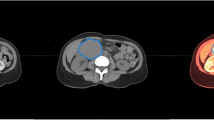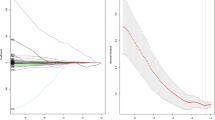Abstract
Objective
To develop and validate a radiomics-based nomogram for preoperatively predicting grade 1 and grade 2/3 tumors in patients with pancreatic neuroendocrine tumors (PNETs).
Methods
One hundred thirty-eight patients derived from two institutions with pathologically confirmed PNETs (104 in the training cohort and 34 in the validation cohort) were included in this retrospective study. A total of 853 radiomic features were extracted from arterial and portal venous phase CT images respectively. Minimum redundancy maximum relevance and random forest methods were adopted for the significant radiomic feature selection and radiomic signature construction. A fusion radiomic signature was generated by combining both the single-phase signatures. The nomogram based on a comprehensive model incorporating the clinical risk factors and the fusion radiomic signature was established, and decision curve analysis was applied for clinical use.
Results
The fusion radiomic signature has significant association with histologic grade (p < 0.001). The nomogram integrating independent clinical risk factor tumor margin and fusion radiomic signature showed strong discrimination with an area under the curve (AUC) of 0.974 (95% CI 0.950–0.998) in the training cohort and 0.902 (95% CI 0.798–1.000) in the validation cohort with good calibration. Decision curve analysis verified the clinical usefulness of the predictive nomogram.
Conclusion
We proposed a comprehensive nomogram consisting of tumor margin and fusion radiomic signature as a powerful tool to predict grade 1 and grade 2/3 PNET preoperatively and assist the clinical decision-making for PNET patients.
Key Points
• Radiomic signature has strong discriminatory ability for the histologic grade of PNETs.
• Arterial and portal venous phase CT imaging are complementary for the prediction of PNET grading.
• The comprehensive nomogram outperformed clinical factors in assisting therapy strategy in PNET patients.






Similar content being viewed by others
Abbreviations
- ACC:
-
Accuracy
- AFP:
-
α-Fetoprotein
- AUC:
-
Area under the curve
- CA199:
-
Carbohydrate antigen 19-9
- CEA:
-
Carcinoembryonic antigen
- CI:
-
Confidence interval
- CT:
-
Computed tomography
- DMPD:
-
Dilatation of the main pancreatic duct
- GLCM:
-
Gray level co-occurrence matrix
- GLDM:
-
Gray level dependence matrix
- GLRLM:
-
Gray level run length matrix
- GLSZM:
-
Gray level size zone matrix
- ICCs:
-
Intra- and inter-class correlation coefficient
- MR:
-
Magnetic resonance
- MRMR:
-
Minimum redundancy maximum relevance
- NGTDM:
-
Neighboring gray tone difference matrix
- NPV:
-
Negative predictive value
- PA:
-
Pancreatic atrophy
- PACS:
-
Picture archiving and communication system
- PBG:
-
Preoperative blood glucose
- PFP:
-
Protrusion from the outline of the pancreas
- PLM:
-
Preoperative liver metastasis
- PNETs:
-
Pancreatic neuroendocrine tumors
- PPV:
-
Positive predictive value
- RF:
-
Random forest
- ROC:
-
Receiver operating characteristics
- ROI:
-
Region of interest
- SENS:
-
Sensitivity
- SPEC:
-
Specificity
- WHO:
-
World Health Organization
References
Yao JC, Hassan M, Phan A et al (2008) One hundred years after “carcinoid”: epidemiology of and prognostic factors for neuroendocrine tumors in 35,825 cases in the United States. J Clin Oncol 26:3063–3072
Ohmoto A, Rokutan H, Yachida S (2017) Pancreatic neuroendocrine neoplasms: basic biology, current treatment strategies and prospects for the future. Int J Mol Sci 18:143
Bosman FT, Carneiro F, Hruban RH, Theise ND (2010) WHO classification of tumours of the digestive system, 4th edn. International Agency for Research on Cancer, Lyon
Reid MD, Balci S, Saka B, Adsay NV (2014) Neuroendocrine tumors of the pancreas: current concepts and controversies. Endocr Pathol 25:65–79
Klimstra DS, Modlin IR, Coppola D, Lloyd RV, Suster S (2010) The pathologic classification of neuroendocrine tumors: a review of nomenclature, grading, and staging systems. Pancreas 39:707–712
Scarpa A, Mantovani W, Capelli P et al (2010) Pancreatic endocrine tumors: improved TNM staging and histopathological grading permit a clinically efficient prognostic stratification of patients. Mod Pathol 23:824–833
Zhou C, Zhang J, Zheng Y, Zhu Z (2012) Pancreatic neuroendocrine tumors: a comprehensive review. Int J Cancer 131:1013–1022
Öberg K (2012) Neuroendocrine tumors of the digestive tract: impact of new classifications and new agents on therapeutic approaches. Curr Opin Oncol 24:433–440
Larghi A, Capurso G, Carnuccio A et al (2012) Ki-67 grading of nonfunctioning pancreatic neuroendocrine tumors on histologic samples obtained by EUS-guided fine-needle tissue acquisition: a prospective study. Gastrointest Endosc 76:570–577
Horiguchi S, Kato H, Shiraha H et al (2017) Dynamic computed tomography is useful for prediction of pathological grade in pancreatic neuroendocrine neoplasm. J Gastroenterol Hepatol 32:925–931
De Robertis R, Cingarlini S, Martini PT et al (2017) Pancreatic neuroendocrine neoplasms: magnetic resonance imaging features according to grade and stage. World J Gastroenterol 23:275–285
Kim JH, Eun HW, Kim YJ, Han JK, Choi BI (2013) Staging accuracy of MR for pancreatic neuroendocrine tumor and imaging findings according to the tumor grade. Abdom Imaging 38:1106–1114
Jang KM, Kim SH, Lee SJ, Choi D (2014) The value of gadoxetic acid-enhanced and diffusion-weighted MRI for prediction of grading of pancreatic neuroendocrine tumors. Acta Radiol 55:140–148
Besa C, Ward S, Cui Y, Jajamovich G, Kim M, Taouli B (2016) Neuroendocrine liver metastases: value of apparent diffusion coefficient and enhancement ratios for characterization of histopathologic grade. J Magn Reson Imaging 44:1432–1441
Belousova E, Karmazanovsky G, Kriger A et al (2017) Contrast-enhanced MDCT in patients with pancreatic neuroendocrine tumours: correlation with histological findings and diagnostic performance in differentiation between tumour grades. Clin Radiol 72:150–158
Min JH, Kang TW, Kim YK et al (2018) Hepatic neuroendocrine tumour: apparent diffusion coefficient as a potential marker of prognosis associated with tumour grade and overall survival. Eur Radiol 28:2561–2571
Hwang EJ, Lee JM, Yoon JH et al (2014) Intravoxel incoherent motion diffusion-weighted imaging of pancreatic neuroendocrine tumors: prediction of the histologic grade using pure diffusion coefficient and tumor size. Invest Radiol 49:396–402
Choi TW, Kim JH, Yu MH, Park SJ, Han JK (2018) Pancreatic neuroendocrine tumor: prediction of the tumor grade using CT findings and computerized texture analysis. Acta Radiol 59:383–392
Canellas R, Burk KS, Parakh A, Sahani DV (2018) Prediction of pancreatic neuroendocrine tumor grade based on CT features and texture analysis. AJR Am J Roentgenol 210:341–346
Guo C, Chen X, Xiao W, Wang Q, Sun K, Wang Z (2017) Pancreatic neuroendocrine neoplasms at magnetic resonance imaging: comparison between grade 3 and grade 1/2 tumors. Onco Targets Ther 10:1465
Kim DW, Kim HJ, Kim KW et al (2015) Neuroendocrine neoplasms of the pancreas at dynamic enhanced CT: comparison between grade 3 neuroendocrine carcinoma and grade 1/2 neuroendocrine tumour. Eur Radiol 25:1375–1383
Kang J, Ryu JK, Son JH et al (2018) Association between pathologic grade and multiphase computed tomography enhancement in pancreatic neuroendocrine neoplasm. J Gastroenterol Hepatol 33:1677–1682
Zhao W, Quan Z, Huang X et al (2018) Grading of pancreatic neuroendocrine neoplasms using pharmacokinetic parameters derived from dynamic contrast-enhanced MRI. Oncol Lett 15:8349–8356
Lambin P, Leijenaar R, Deist TM et al (2017) Radiomics: the bridge between medical imaging and personalized medicine. Nat Rev Clin Oncol 14:749
Aerts HJ, Velazquez ER, Leijenaar RT et al (2014) Decoding tumour phenotype by noninvasive imaging using a quantitative radiomics approach. Nat Commun 5:4006
Chen J, Tian J (2009) Real-time multi-modal rigid registration based on a novel symmetric-SIFT descriptor. Progress in Natural Science-Materials International 19:643-651
Cameron A, Khalvati F, Haider MA, Wong A (2016) MAPS: a quantitative radiomics approach for prostate cancer detection. IEEE Trans Biomed Eng 63:1145–1156
Huang YQ, Liang CH, He L et al (2016) Development and validation of a radiomics nomogram for preoperative prediction of lymph node metastasis in colorectal cancer. J Clin Oncol 34:2157–2164
Liu Z, Zhang XY, Shi YJ et al (2017) Radiomics analysis for evaluation of pathological complete response to neoadjuvant chemoradiotherapy in locally advanced rectal cancer. Clin Cancer Res 23:7253–7262
Elhalawani H, Kanwar A, Mohamed ASR et al (2018) Investigation of radiomic signatures for local recurrence using primary tumor texture analysis in oropharyngeal head and neck cancer patients. Sci Rep 8:13
Ger RB, Cardenas CE, Anderson BM, Yang J, Mackin DS, Zhang L (2018) Guidelines and experience using imaging biomarker explorer (IBEX) for Radiomics. J Vis Exp:e57132
Zhang B, Tian J, Dong D et al (2017) Radiomics Features of Multiparametric MRI as Novel Prognostic Factors in Advanced Nasopharyngeal Carcinoma. Clin Cancer Res 23:4259–4269
Ding JL, Xing ZY, Jiang ZX et al (2018) CT-based radiomic model predicts high grade of clear cell renal cell carcinoma. Eur J Radiol 103:51–56
Huang X, Cheng Z, Huang Y et al (2018) CT-based radiomics signature to discriminate high-grade from Low-grade colorectal adenocarcinoma. Acad Radiol. https://doi.org/10.1016/j.acra.2018.01.020
Tian Q, Yan LF, Zhang X et al (2018) Radiomics strategy for glioma grading using texture features from multiparametric MRI. J Magn Reson Imaging. https://doi.org/10.1002/jmri.26010
Peng H, Long F, Ding C (2005) Feature selection based on mutual information criteria of max-dependency, max-relevance, and min-redundancy. IEEE Trans Pattern Anal Mach Intell 27:1226–1238
Phuong TM, Lin Z, Altman RB (2005) Choosing SNPs using feature selection. Computational Systems Bioinformatics Conference 301–309
Kramer AA, Zimmerman JE (2007) Assessing the calibration of mortality benchmarks in critical care: the Hosmer-Lemeshow test revisited. Crit Care Med 35:2052–2056
Vickers AJ, Elkin EB (2006) Decision curve analysis: a novel method for evaluating prediction models. Med Decis Mak 26:565–574
Hu Y, Rao S, Xu X, Tang Y, Zeng M (2018) Grade 2 pancreatic neuroendocrine tumors: overbroad scope of Ki-67 index according to MRI features. Abdom Radiol (NY). https://doi.org/10.1007/s00261-018-1573-5
Kasajima A, Yazdani S, Sasano H (2015) Pathology diagnosis of pancreatic neuroendocrine tumors. J Hepatobiliary Pancreat Sci 22:586–593
Parmar C, Grossmann P, Bussink J, Lambin P, Aerts HJ (2015) Machine learning methods for quantitative radiomic biomarkers. Sci Rep 5:13087
Breiman L (2001) Random forests. Mach Learn 45:5–32
Horton KM, Hruban RH, Yeo C, Fishman EK (2006) Multi–detector row CT of pancreatic islet cell tumors. Radiographics 26:453–464
Low G, Panu A, Millo N, Leen E (2011) Multimodality imaging of neoplastic and non-neoplastic solid lesions of the pancreas. Radiographics 31:993–1015
Valle JW, Eatock M, Clueit B, Gabriel Z, Ferdinand R, Mitchell S (2014) "A systematic review of non-surgical treatments for pancreatic neuroendocrine tumours" (vol 40, pg 376, 2014). Cancer Treat Rev 40:1037–1037
Funding
This study has received funding by the National Natural Science Foundation of China (No. 81227901, 81527805, 61231004, 81771924, 81501616), National Key Research and Development Program of China (2017YFA0205200, 2017YFC1308700), and the Science and Technology Service Network Initiative of the Chinese Academy of Sciences (KFJ-SW-STS-160).
Author information
Authors and Affiliations
Corresponding authors
Ethics declarations
Guarantor
The scientific guarantor of this publication is Jie Tian.
Conflict of interest
The authors declare that they have no competing interests.
Statistics and biometry
Dr. Jingwei Wei from the University of Chinese Academy of Sciences, who is one of the authors, has significant statistical expertise.
Informed consent
Written informed consent was waived by the Institutional Review Board of Zhongshan Hospital Affiliated to Shanghai Fudan University and Affiliated Hospital (Laoshan hospital) of Qingdao University.
Ethical approval
Institutional Review Board approval was obtained.
Methodology
• retrospective
• diagnostic or prognostic study
• multicenter study
Additional information
Publisher’s note
Springer Nature remains neutral with regard to jurisdictional claims in published maps and institutional affiliations.
Electronic supplementary material
ESM 1
(DOCX 1238 kb)
Rights and permissions
About this article
Cite this article
Gu, D., Hu, Y., Ding, H. et al. CT radiomics may predict the grade of pancreatic neuroendocrine tumors: a multicenter study. Eur Radiol 29, 6880–6890 (2019). https://doi.org/10.1007/s00330-019-06176-x
Received:
Revised:
Accepted:
Published:
Issue Date:
DOI: https://doi.org/10.1007/s00330-019-06176-x




